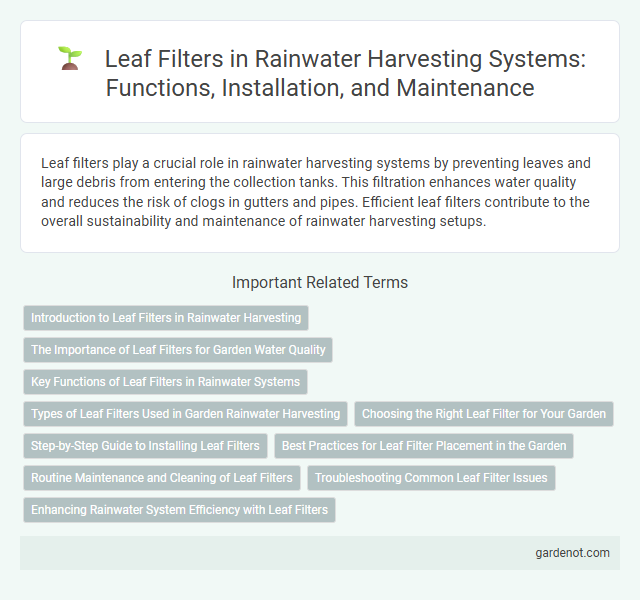Leaf filters play a crucial role in rainwater harvesting systems by preventing leaves and large debris from entering the collection tanks. This filtration enhances water quality and reduces the risk of clogs in gutters and pipes. Efficient leaf filters contribute to the overall sustainability and maintenance of rainwater harvesting setups.
Introduction to Leaf Filters in Rainwater Harvesting
Leaf filters are essential components in rainwater harvesting systems designed to prevent leaves and large debris from entering storage tanks. These filters are typically installed at the gutters or downpipes, ensuring cleaner water collection by blocking organic matter that can cause clogging and contamination. Effective leaf filtration enhances water quality and prolongs the lifespan of the rainwater harvesting infrastructure.
The Importance of Leaf Filters for Garden Water Quality
Leaf filters play a crucial role in enhancing garden water quality by preventing leaves and debris from entering rainwater harvesting systems. These filters reduce contamination, thereby minimizing the risk of clogged pipes and reducing the presence of harmful pathogens in collected water. Maintaining clean rainwater through efficient leaf filtration supports healthier plant growth and sustainable garden irrigation.
Key Functions of Leaf Filters in Rainwater Systems
Leaf filters in rainwater harvesting systems play a crucial role by preventing debris such as leaves, twigs, and insects from entering the water storage tanks, ensuring cleaner and safer water collection. These filters enhance system efficiency by reducing blockages and minimizing maintenance needs, thereby prolonging the lifespan of pumps and pipes. Effective leaf filtration improves water quality, making harvested rainwater more suitable for irrigation, household use, and reducing contamination risks.
Types of Leaf Filters Used in Garden Rainwater Harvesting
Leaf filters used in garden rainwater harvesting include mesh screens, perforated leaf guards, and brush strips, each designed to prevent debris from clogging storage systems. Mesh screens, typically made from stainless steel or synthetic materials, offer fine filtration by trapping small leaves and dirt while allowing water to pass through efficiently. Perforated leaf guards and brush strips act as physical barriers on gutters, capturing larger leaves and organic matter, reducing maintenance and ensuring cleaner rainwater collection for garden use.
Choosing the Right Leaf Filter for Your Garden
Selecting the right leaf filter for your garden involves evaluating the type of debris common in your area, such as leaves, twigs, and pollen, to ensure efficient rainwater collection. High-quality stainless steel mesh filters provide durability and fine filtration, preventing clogging and maintaining water flow. Consider factors like filter size, ease of installation, and maintenance requirements to optimize your rainwater harvesting system.
Step-by-Step Guide to Installing Leaf Filters
Installing leaf filters begins with measuring the gutter length to ensure the filter fits perfectly. Secure the leaf guard on the gutter by snapping or fastening it, making sure it covers all openings to prevent debris from entering the rainwater system. Regularly inspect and clean the leaf filter to maintain optimal performance and prevent clogs in the rainwater harvesting setup.
Best Practices for Leaf Filter Placement in the Garden
Positioning the leaf filter at the gutter's downspout optimizes debris removal by capturing leaves and preventing clogging in rainwater harvesting systems. Ensure the filter's mesh size balances effective filtration and water flow, avoiding reduced collection efficiency. Regular maintenance, including cleaning the leaf filter after heavy rains, sustains optimal performance and protects garden irrigation components.
Routine Maintenance and Cleaning of Leaf Filters
Routine maintenance and cleaning of leaf filters are essential to ensure optimal rainwater harvesting efficiency by preventing debris buildup and clogging. Regular inspection and removal of accumulated leaves, twigs, and dirt maintain unobstructed water flow and extend the filter's lifespan. Cleaning frequency depends on local vegetation density but typically ranges from biweekly to monthly to sustain peak performance.
Troubleshooting Common Leaf Filter Issues
Leaf filters in rainwater harvesting systems often face blockages caused by accumulated debris and organic matter, reducing water flow efficiency. Regular inspection and cleaning of the mesh or screen prevent clogging and ensure optimal filtration performance. Addressing rust or wear promptly maintains the filter's durability and prevents contamination of the collected water.
Enhancing Rainwater System Efficiency with Leaf Filters
Leaf filters play a crucial role in enhancing rainwater harvesting system efficiency by preventing debris, leaves, and other contaminants from entering storage tanks. These filters improve water quality and reduce maintenance frequency, ensuring consistent water flow and prolonged system longevity. Integrating high-quality leaf filters optimizes filtration, minimizes clogging, and supports sustainable rainwater collection.
Leaf filter Infographic

 gardenot.com
gardenot.com